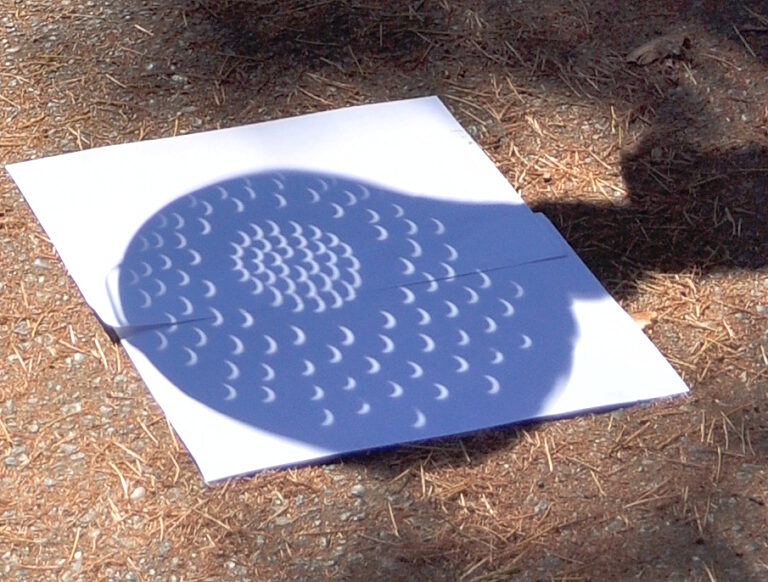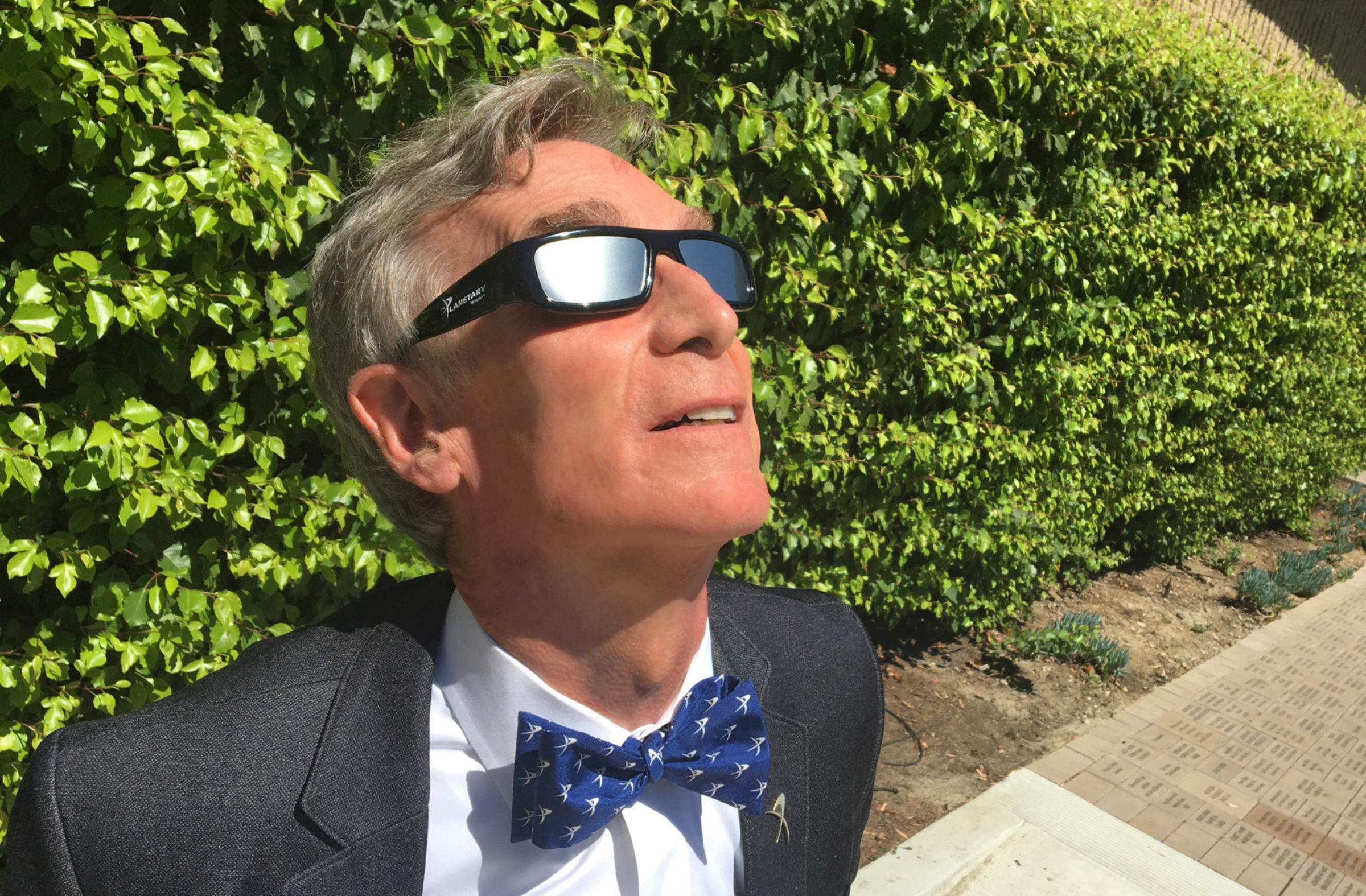Kate Howells • Sep 07, 2023
Are your solar eclipse glasses safe?
How to protect your eyes during a solar eclipse
Solar eclipses are among the most spectacular cosmic phenomena visible from Earth, but they have to be enjoyed safely. Because observing a partial, annular, or total solar eclipse involves looking at the Sun, it’s essential that you only do so with proper safety equipment. The most common way to safely view an eclipse is through solar eclipse glasses.
What are solar eclipse glasses?
Solar eclipse glasses use lenses that are made of black polymer, a flexible resin infused with carbon particles. They are about 100,000 times darker than ordinary sunglasses and block nearly all visible light as well as all infrared and ultraviolet light.
The same lenses are sometimes used in solar viewing cards that you hold over your eyes with your hand. Although this article will talk about eclipse glasses because they’re more common, the same things apply to handheld solar viewers.
How can you tell if your eclipse glasses are safe?
Eclipse glasses have their safety certified by the International Organization for Standardization (ISO). You can tell if a pair of solar eclipse glasses meet today’s standards if they are labeled ISO 12312-2 (sometimes written as ISO 12312-2:2015). Eclipse glasses manufacturers send their products to specialized labs that test whether the lenses comply with the ISO 12312-2 safety specifications.
Unfortunately, some vendors sell solar eclipse glasses with the ISO label that haven’t actually been tested and certified. The only way to be totally sure that your eclipse glasses are safe is to buy them from a source that the American Astronomical Society (AAS) has approved as reputable. The AAS reviews hundreds of solar eclipse glasses vendors to check that they have actually been tested and approved by the ISO, and to perform their own examinations of the products. They have a list of all their approved reputable vendors that you can check.
Planetary Society eclipse glasses
You can buy special Planetary Society eclipse glasses from AAS-approved vendor American Paper Optics. Every purchase supports The Planetary Society’s work. Eclipse glasses always sell out early, so get yours today!
Aside from being sure they come from a reputable source, there are ways to check that your solar eclipse glasses are safe and in good condition. Make sure that the lenses aren’t scratched, torn, or punctured, and that they aren’t coming loose from the cardboard frame. If your solar eclipse glasses are in poor condition, don’t use them.
You can also sometimes tell if a pair of eclipse glasses that claims to be ISO-compliant isn’t really safe by trying them on and looking at bright objects other than the Sun. First, try looking at things like a shaded lamp in your home. If you can see that light, your eclipse glasses aren’t strong enough. If you try this and can’t see the light, try looking at something brighter like a bare lightbulb. This should appear dim through a safe solar lens. If that works, you can try glancing at the Sun through your eclipse glasses. If you find it uncomfortably bright, out of focus, and/or surrounded by a bright haze, this is another sign that your eclipse glasses aren’t safe.
Are your eclipse glasses safe? Here's how to know if your eclipse glasses are safe for watching a partial or total solar eclipse. Plus, some common alternatives you should definitely avoid.
Common alternatives that you should avoid
You may have heard people say that other materials can be used in place of eclipse glasses, but this is almost always untrue. The AAS has specifically identified the following as commonly suggested alternatives that are unsafe:
Ordinary sunglasses or multiple pairs of sunglasses stacked on top of each other
Neutral density or polarizing filters, such as those made for camera lenses
Smoked glass
Photographic or X-ray film (unexposed, exposed, or developed)
Emergency blankets
Potato-chip bags
DVDs
Some of these filters may seem to dim the Sun to the point that it’s comfortable to look at, but you might still be exposing your eyes to damaging infrared and ultraviolet rays. These rays can harm both your cornea (at the front of your eye) and the retina (in the back).
The only alternative to solar eclipse glasses that NASA and the AAS say is safe are welder's glasses rated 14 or higher.
How to enjoy a solar eclipse without glasses
If you can’t find solar eclipse glasses, you can still enjoy the celestial spectacle in other ways.
During eclipses many communities have star parties, sometimes organized by amateur astronomy groups, local observatories, and organizations like The Planetary Society. If you get a chance to attend a star party for an eclipse, you could see it through a telescope that’s been fitted with a solar lens for safely viewing the Sun.
If you don’t have a star party nearby, you can still enjoy interesting phenomena that happen during an eclipse and see the eclipse itself indirectly. During a partial eclipse or the parts of a total eclipse before and after the Moon completely obscures the Sun, you can see the crescent shape of the Sun through shadows. Try holding a colander up to the Sun and looking at its shadow on pavement or a piece of paper on the ground; you’ll see that each hole in the colander looks like a crescent instead of a circle.

You can also do something similar by poking a very small hole in a piece of paper or cardboard, holding it up, and looking at how the Sun’s light projects through it onto the ground. It’s extremely important with both of these methods to never look up through the hole at the Sun; only look at the shadow of what you’re holding up to see how the Sun’s light comes through the holes.
How to Make a Pinhole Projector Want to see an eclipse without wearing solar glasses? Try this easy trick to make a pinhole projector.
If you’re watching a total solar eclipse, the only time you can safely look directly at it without eclipse glasses is during the totality phase, when the Moon is completely blocking the Sun. You’ll know this is happening when the whole sky gets dark. This phase generally only lasts a few minutes, and it’s important that you look away again as soon as you see the Sun start to reappear.
Finally, you can always watch a live stream of a solar eclipse on NASA’s website. You’ll get to see the Sun being eclipsed through a special solar telescope, giving you a much bigger, more detailed view of the event than you’d get by seeing it in person. This is worth checking out if you can’t see the eclipse in person because of location, bad weather, or lack of safe viewing materials.


 Explore Worlds
Explore Worlds Find Life
Find Life Defend Earth
Defend Earth


